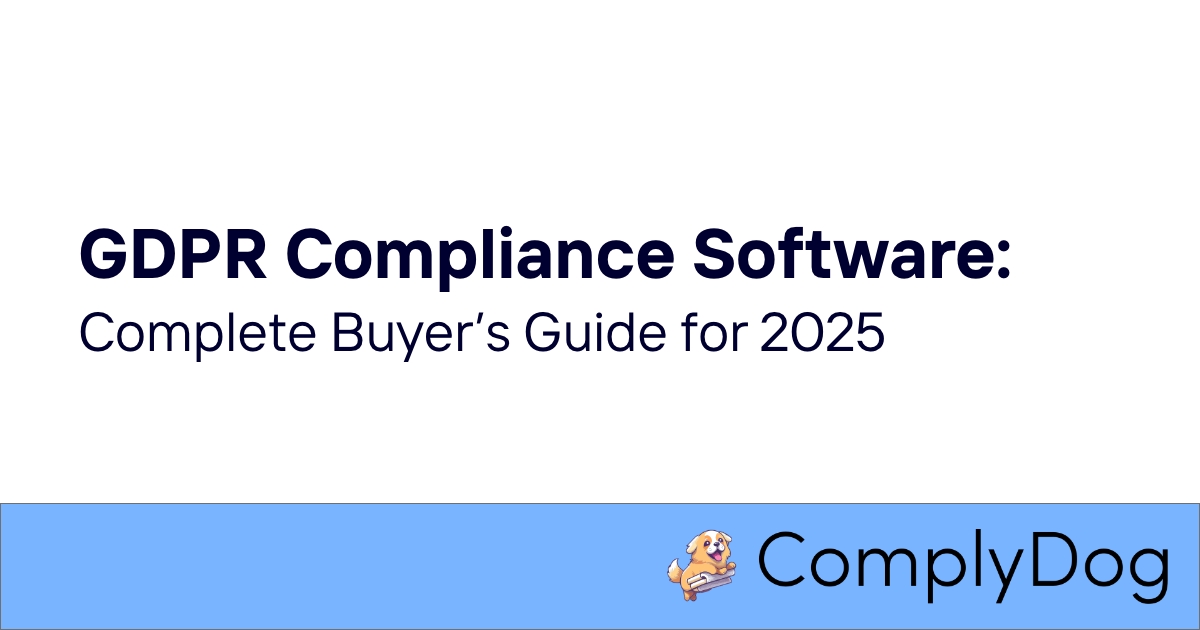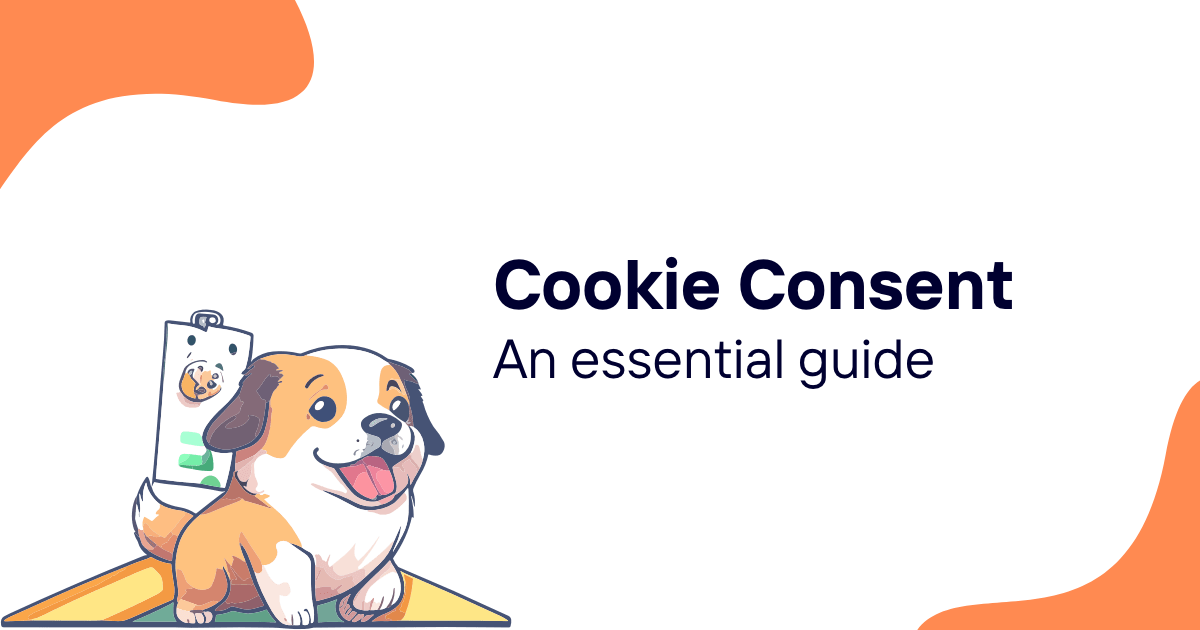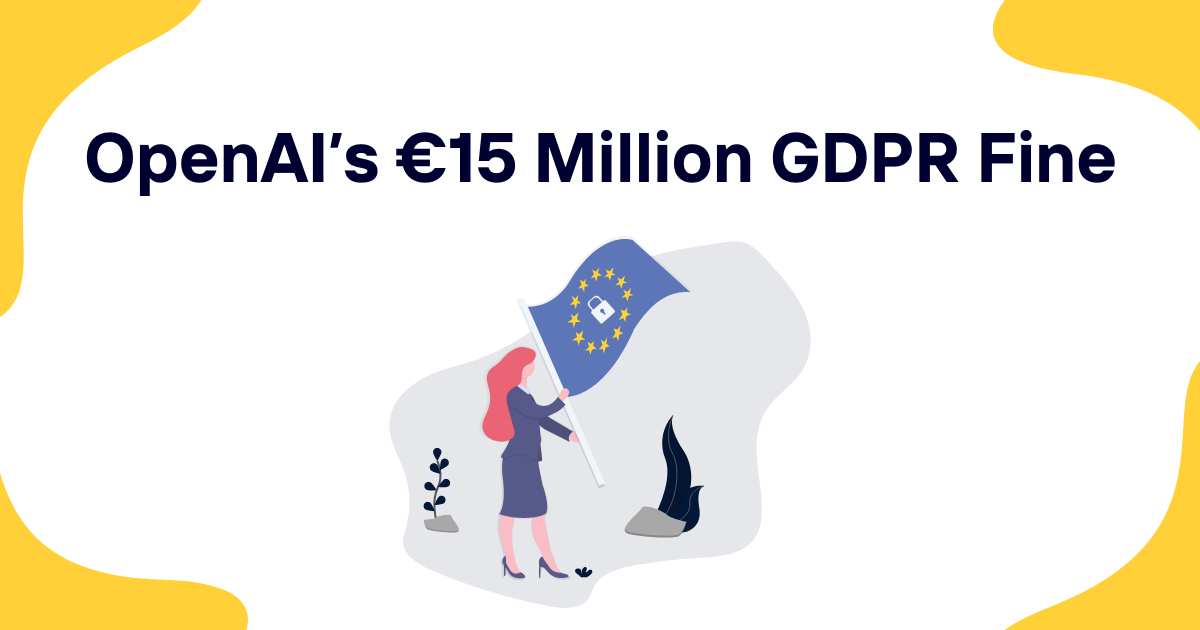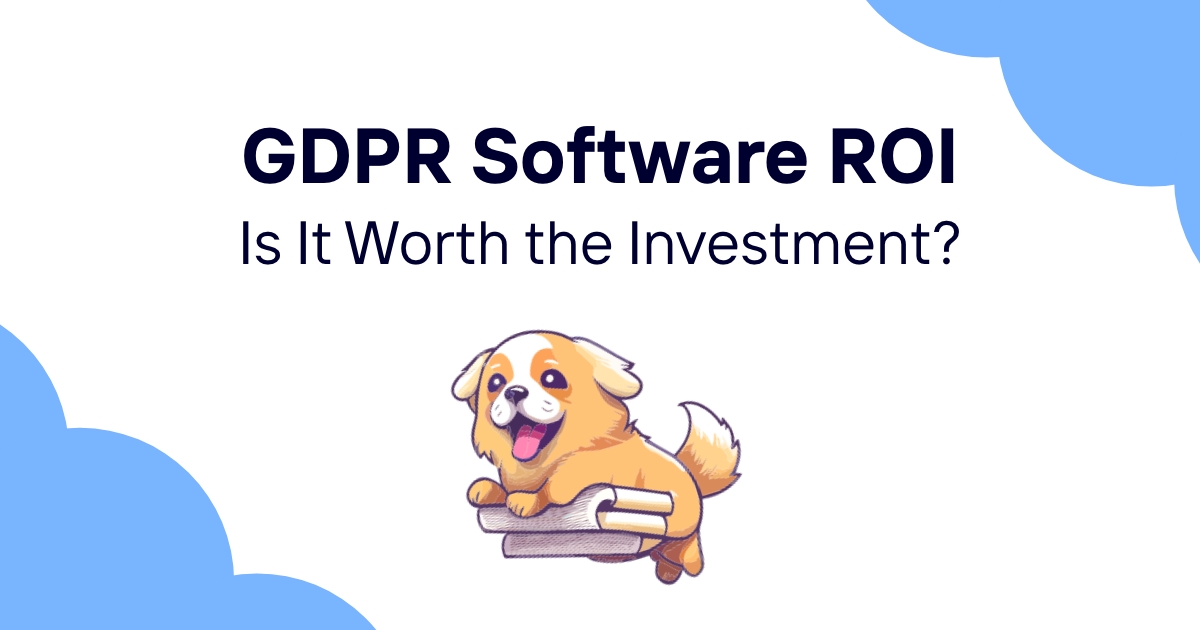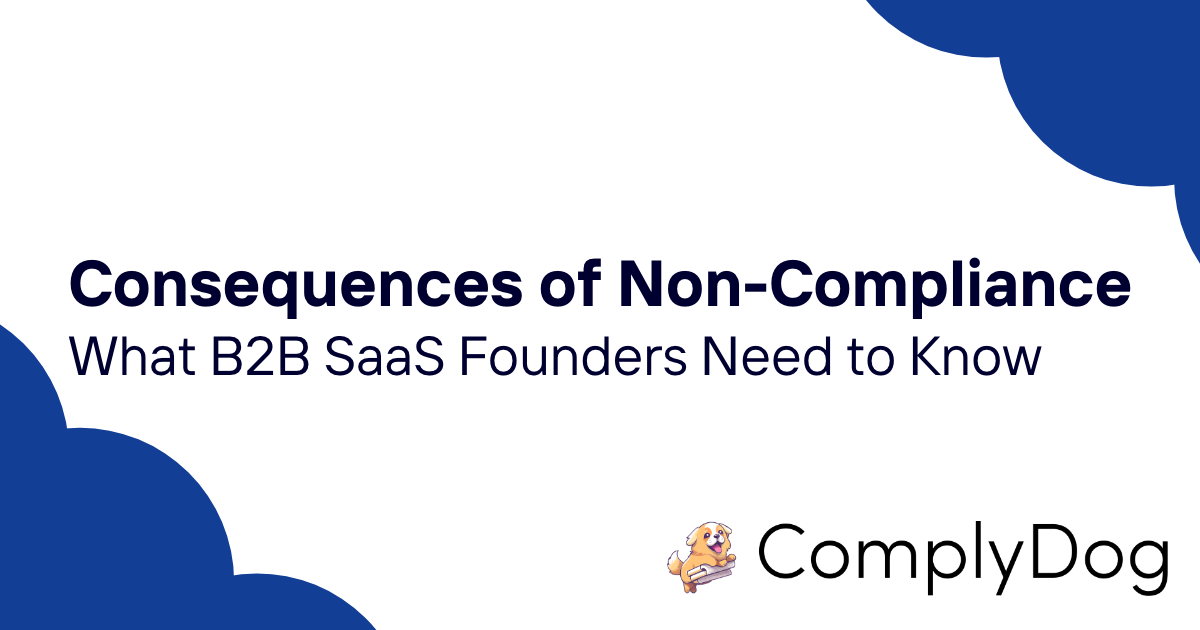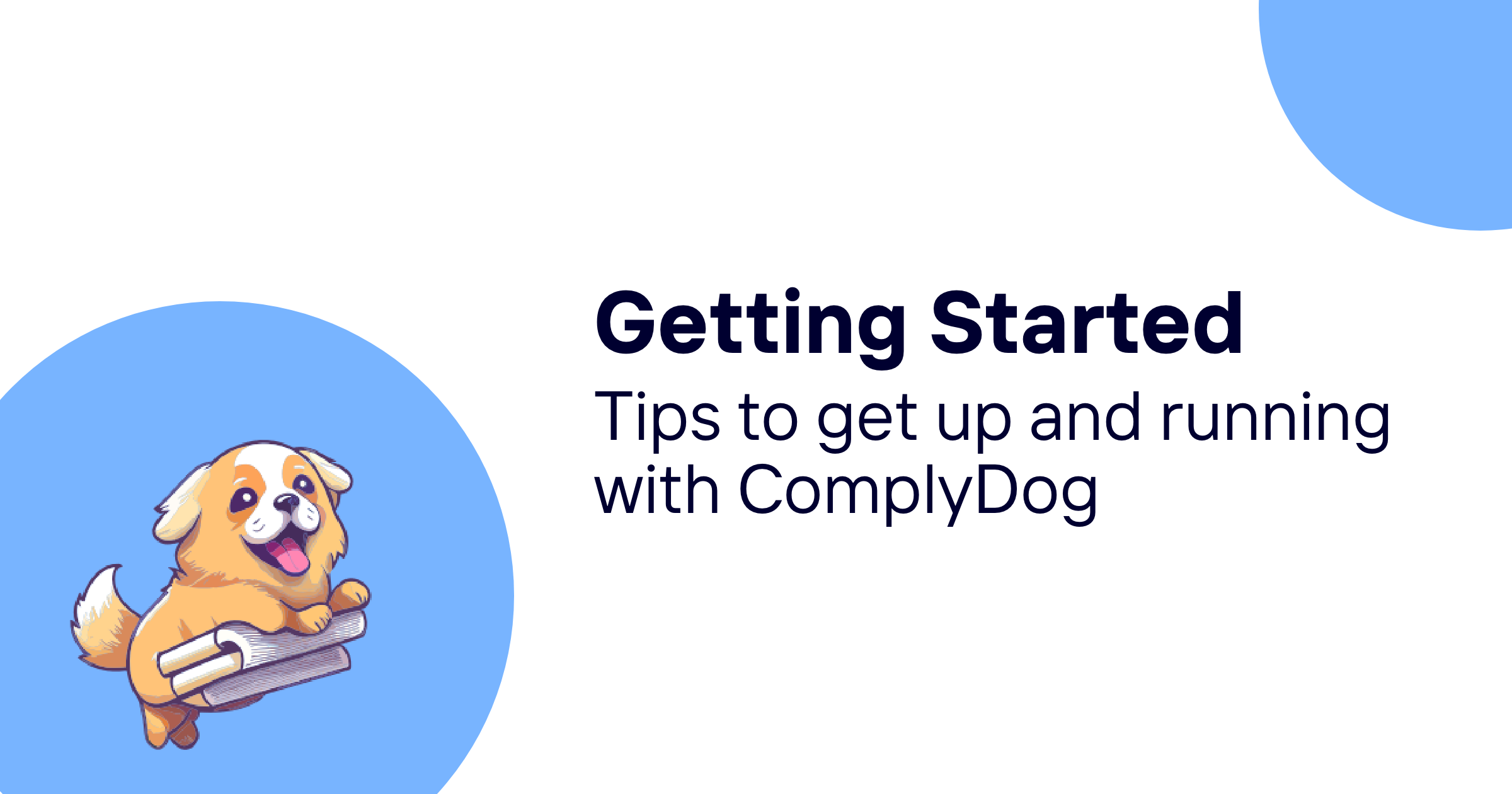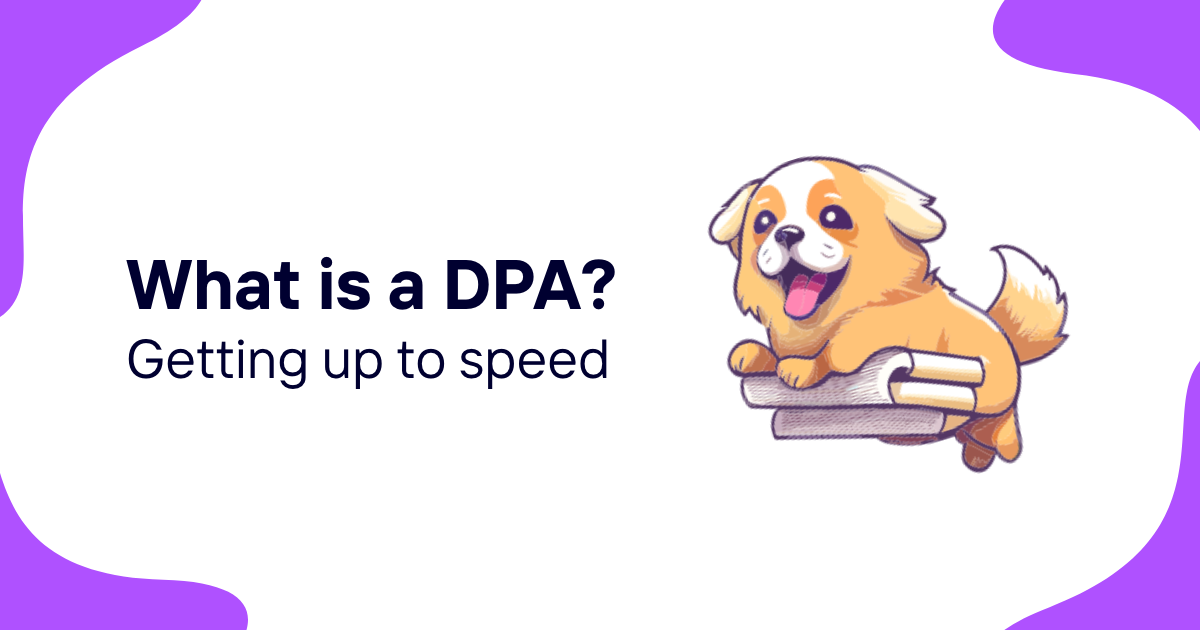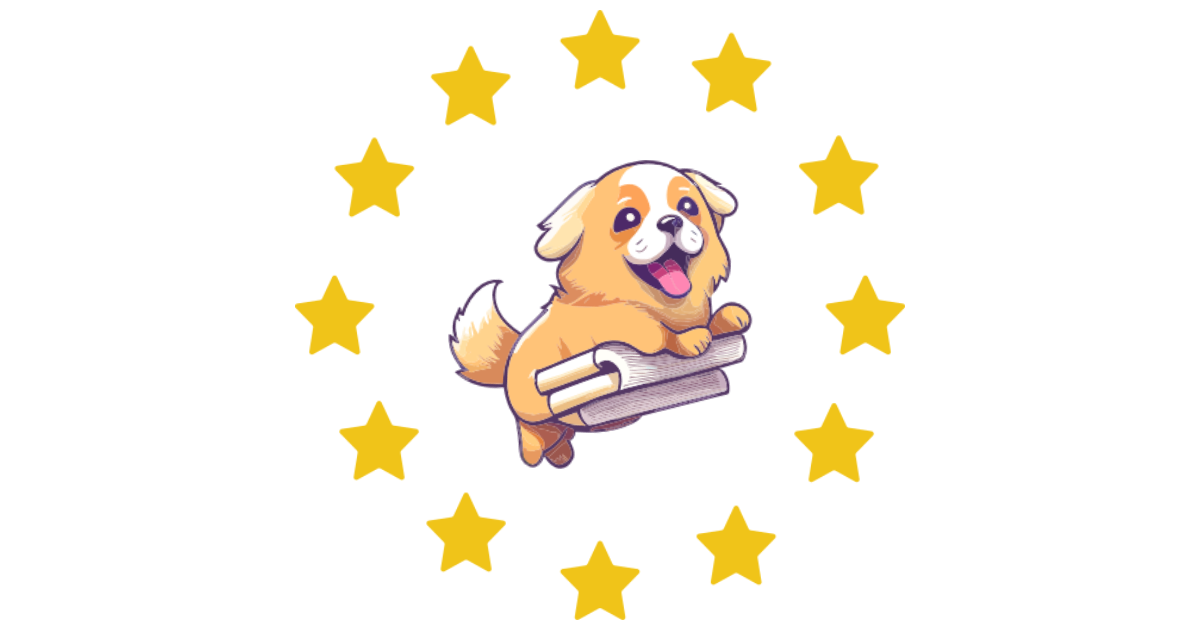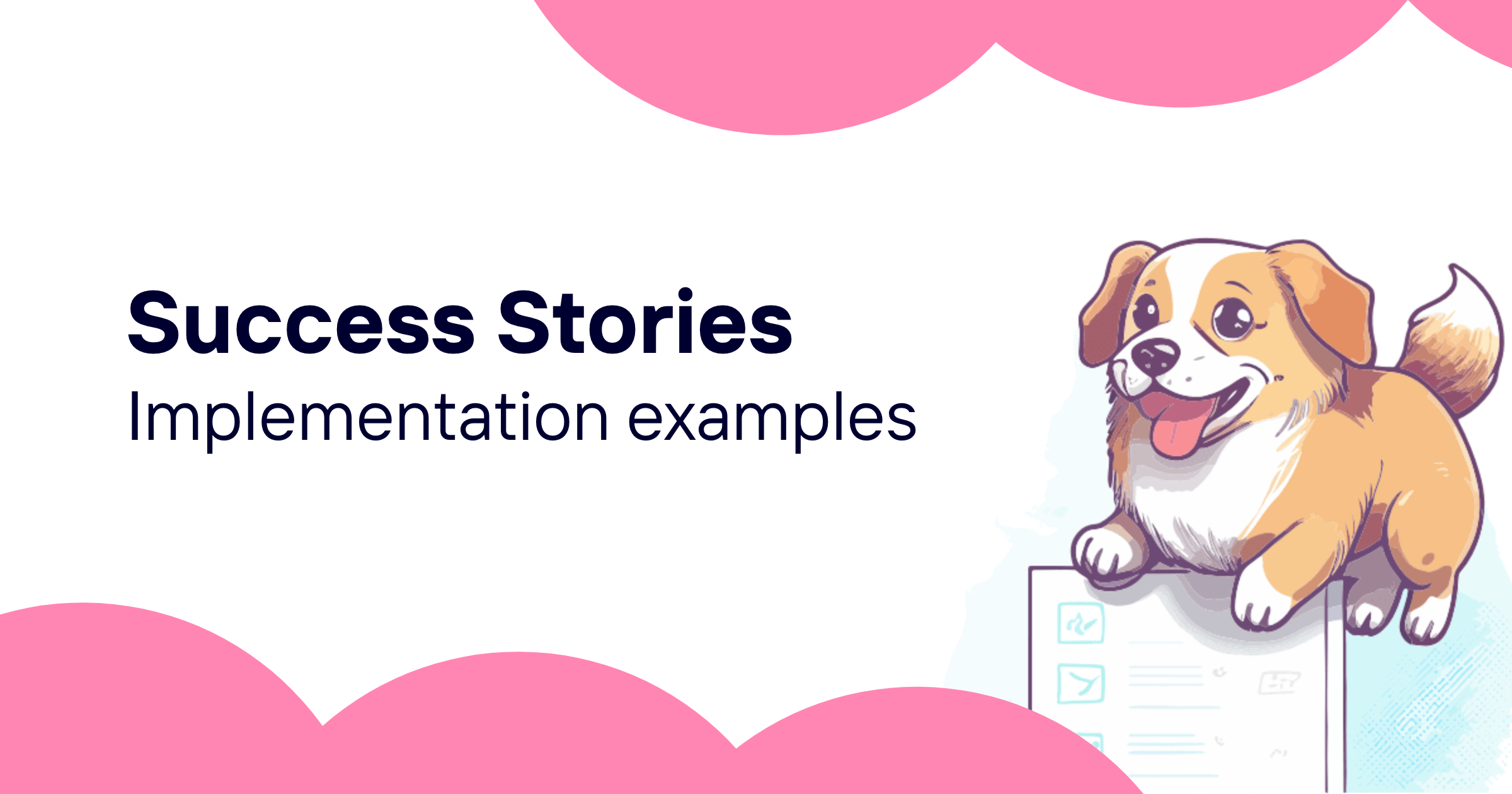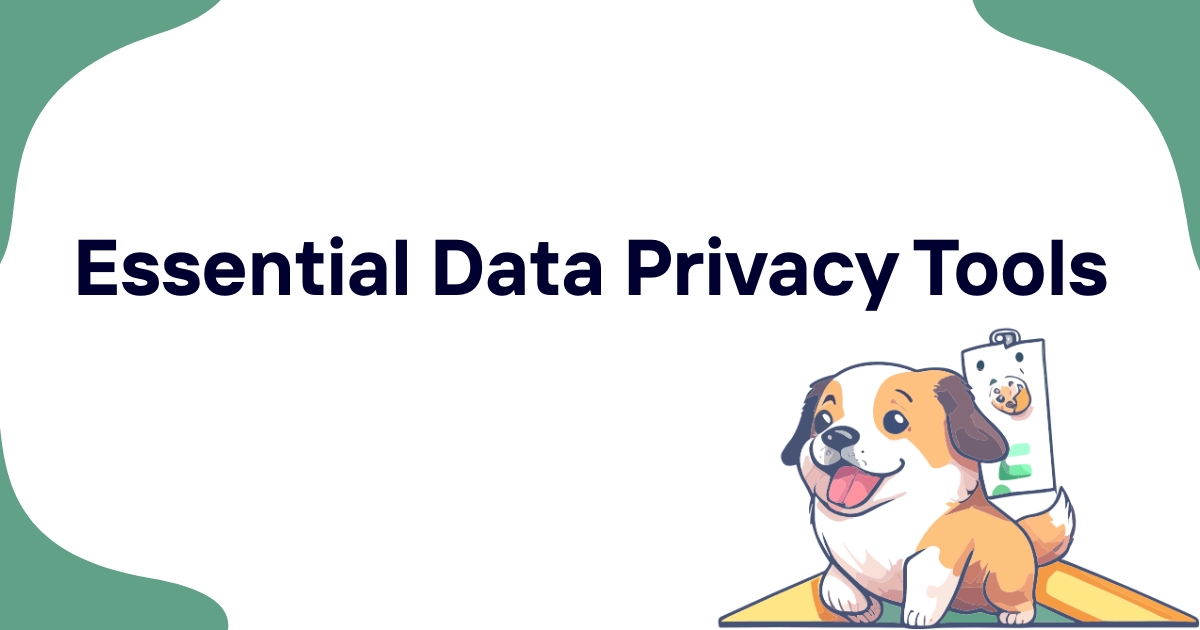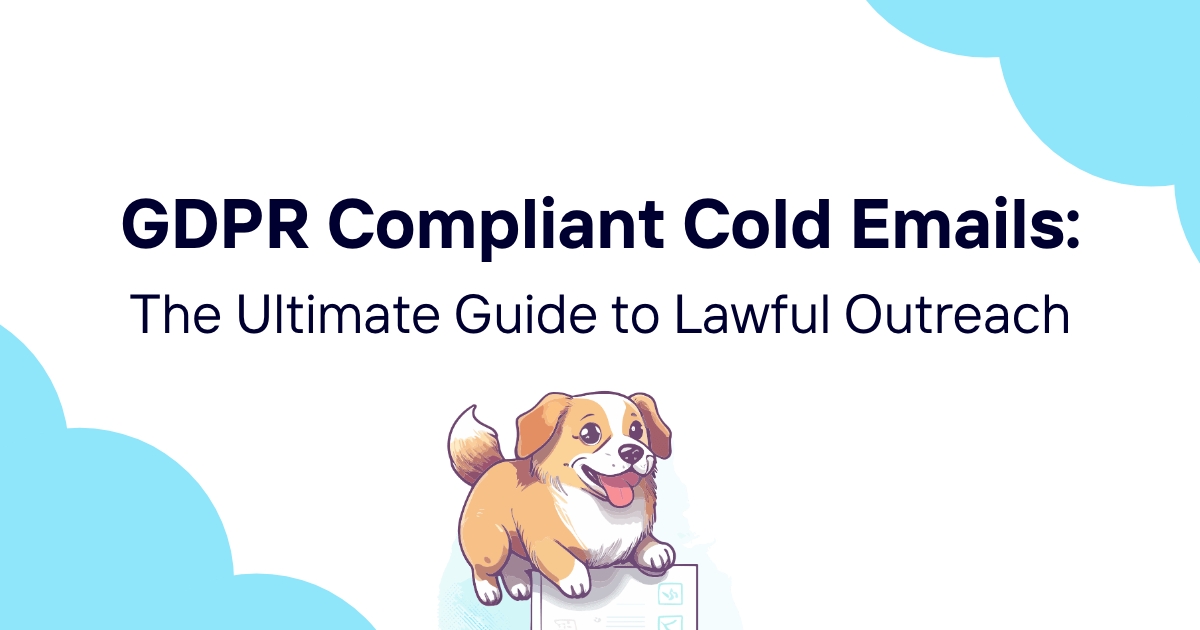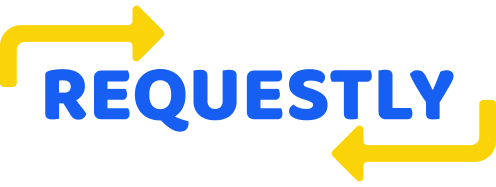Choosing the right GDPR compliance software can make the difference between efficient regulatory compliance and costly manual processes that drain resources while creating compliance risks. With the growing complexity of data protection requirements and increasing enforcement actions, investing in proper compliance software has become essential for businesses of all sizes.
This comprehensive buyer's guide walks you through everything you need to know about GDPR compliance software, from essential features to pricing considerations. Whether you're implementing your first compliance solution or upgrading existing systems, this guide helps you make informed decisions that protect your business while supporting growth.
Why GDPR Compliance Software is Essential
Manual GDPR compliance processes simply cannot keep pace with modern business requirements. The regulation's complexity, combined with strict timelines and severe penalties, makes automated compliance software a business necessity rather than a luxury.
Complexity of Modern Data Environments
Today's businesses operate complex technology ecosystems that make manual compliance tracking nearly impossible:
Multi-System Data Storage: Personal data typically spreads across databases, cloud services, backup systems, and third-party applications, making manual discovery time-consuming and error-prone.
Dynamic Data Flows: Modern applications constantly create, modify, and delete personal data through automated processes that manual tracking cannot adequately monitor.
Integration Dependencies: Business systems increasingly rely on APIs, webhooks, and real-time data synchronization that create complex compliance requirements.
Scale Challenges: Growing businesses handle increasing volumes of personal data and data subject requests that quickly overwhelm manual processes.
Regulatory Risk and Enforcement Trends
GDPR enforcement continues intensifying, with data protection authorities imposing significant penalties for compliance failures:
Increasing Fine Amounts: Recent enforcement actions show regulators imposing substantial penalties, with some fines reaching hundreds of millions of euros.
Broader Enforcement Scope: Authorities are expanding beyond obvious violations to examine technical compliance details and operational procedures.
Cross-Border Cooperation: Enhanced cooperation between European data protection authorities means violations in one country can trigger investigations across multiple jurisdictions.
Individual Rights Focus: Regulators increasingly focus on companies' ability to respond effectively to data subject access requests and other individual rights.
Business Efficiency and Growth
Compliance software provides business benefits beyond regulatory protection:
Resource Optimization: Automated compliance processes free staff to focus on revenue-generating activities rather than manual compliance tasks.
Customer Trust: Demonstrable compliance capabilities enhance customer confidence and can provide competitive advantages in privacy-conscious markets.
Operational Scaling: Automated systems enable businesses to grow without proportionally increasing compliance overhead.
Decision Support: Compliance dashboards and reporting provide valuable insights for business planning and risk management.
Cost-Benefit Analysis
While compliance software requires upfront investment, the costs of manual compliance or non-compliance far exceed software expenses:
Manual Process Costs: Staff time for manual data discovery, rights request processing, and compliance documentation typically costs more than software solutions.
Violation Penalties: GDPR fines can reach 4% of annual global revenue, making even expensive compliance software a cost-effective investment.
Breach Response Costs: Data breaches involving manual compliance failures often result in higher response costs and longer recovery times.
Opportunity Costs: Manual compliance processes consume resources that could otherwise support business growth and innovation.
Key Features to Look for in GDPR Software
Effective GDPR compliance software must address all major regulation requirements while integrating seamlessly with existing business operations.
Data Discovery and Mapping
Comprehensive data discovery forms the foundation of effective GDPR compliance:
Automated Data Scanning: Software should automatically identify personal data across databases, file systems, cloud storage, and applications using pattern recognition and machine learning.
Real-Time Discovery: Systems should continuously monitor for new personal data rather than requiring manual scans or periodic updates.
Classification Capabilities: Software should categorize personal data by type, sensitivity level, and regulatory requirements to enable appropriate protection measures.
Data Flow Visualization: Clear mapping of how personal data moves through systems helps identify compliance requirements and potential risks.
Integration Support: Discovery tools should work with popular business applications, databases, and cloud platforms without requiring extensive customization.
Data Subject Rights Management
Efficient processing of individual rights requests is essential for GDPR compliance:
Multi-Channel Request Intake: Software should capture rights requests from email, web forms, phone calls, and other communication channels.
Identity Verification: Built-in tools for verifying requester identity while maintaining security and user experience.
Automated Data Compilation: Systems should automatically locate and compile all personal data associated with specific individuals across all connected systems.
Response Generation: Automated creation of compliant responses that include all required information in user-friendly formats.
Timeline Management: Automated tracking and alerts to ensure responses meet GDPR's strict deadlines.
Quality Assurance: Built-in review processes that verify response accuracy and completeness before delivery.
As detailed in our DSAR complete guide, effective rights request processing requires sophisticated automation to meet regulatory timelines while maintaining accuracy.
Privacy Impact Assessment Tools
GDPR requires privacy impact assessments for high-risk processing activities:
Assessment Templates: Pre-built templates that guide users through comprehensive privacy impact evaluations.
Risk Scoring: Automated risk assessment that identifies high-risk processing activities requiring formal impact assessments.
Mitigation Tracking: Tools for documenting risk mitigation measures and monitoring implementation effectiveness.
Stakeholder Collaboration: Features that enable multiple team members to contribute to impact assessments and review processes.
Regulatory Integration: Templates and workflows that align with specific data protection authority guidance and requirements.
Consent Management
When processing relies on consent, software must provide comprehensive consent tracking:
Consent Capture: Tools for collecting explicit consent through web forms, applications, and other user interfaces.
Preference Centers: User-friendly interfaces that allow individuals to manage their consent preferences and privacy settings.
Consent Records: Detailed logging of when, how, and for what purposes consent was obtained from each individual.
Withdrawal Processing: Automated systems for processing consent withdrawal and halting related processing activities.
Consent Refresh: Tools for periodically validating and refreshing consent when appropriate for business relationships.
Vendor and DPA Management
Managing third-party relationships requires specialized tools:
Vendor Assessment: Systematic evaluation of vendor privacy and security practices through questionnaires and assessments.
DPA Automation: Streamlined processes for creating, negotiating, and executing data processing agreements with vendors.
Compliance Monitoring: Ongoing tracking of vendor compliance with contractual commitments and regulatory requirements.
Risk Scoring: Automated assessment of vendor-related privacy risks based on data access, security practices, and compliance history.
As outlined in our DPA meaning guide, effective vendor management requires comprehensive tracking of all processor relationships and their compliance status.
Incident Response and Breach Management
Security incident management capabilities are essential for GDPR compliance:
Incident Detection: Automated monitoring that identifies potential data breaches and security incidents.
Response Workflows: Structured processes for investigating, containing, and resolving security incidents.
Notification Management: Automated systems for notifying regulatory authorities and affected individuals within required timeframes.
Documentation Tools: Comprehensive logging of incident response activities for compliance verification and lessons learned.
Recovery Tracking: Tools for monitoring incident resolution and implementing preventive measures.
Reporting and Analytics
Comprehensive reporting supports both compliance verification and business decision-making:
Compliance Dashboards: Real-time visibility into compliance status, outstanding requests, and potential issues.
Regulatory Reporting: Automated generation of reports required by data protection authorities.
Performance Analytics: Metrics and KPIs that track compliance program effectiveness and identify improvement opportunities.
Audit Support: Comprehensive documentation and reporting that supports internal audits and regulatory examinations.
Executive Reporting: High-level summaries and metrics appropriate for board and executive review.
GDPR Software Types and Categories
GDPR compliance software comes in various forms, from comprehensive platforms to specialized point solutions. Understanding these categories helps identify the best approach for your specific needs.
Comprehensive Compliance Platforms
All-in-one platforms provide integrated approaches to GDPR compliance:
Unified Data Management: Single platforms that handle data discovery, mapping, and lifecycle management across all business systems.
Integrated Rights Management: Combined tools for processing access requests, deletion requests, and other individual rights within the same platform.
End-to-End Workflows: Seamless processes that connect data discovery, rights processing, vendor management, and incident response.
Centralized Reporting: Unified dashboards and reporting that provide complete visibility into all compliance activities.
Single Vendor Relationship: Simplified vendor management with single points of contact for support, updates, and compliance assistance.
Specialized Point Solutions
Focused tools address specific aspects of GDPR compliance:
Data Discovery Tools: Specialized software for locating and classifying personal data across complex technology environments.
Rights Request Platforms: Dedicated systems for managing data subject access requests and other individual rights.
Consent Management Platforms: Specialized tools for collecting, tracking, and managing user consent across multiple touchpoints.
Privacy Impact Assessment Tools: Focused solutions for conducting and managing privacy impact assessments.
Vendor Risk Management: Specialized platforms for assessing and monitoring third-party privacy and security risks.
Cloud-Native vs On-Premises Solutions
Deployment models affect functionality, security, and maintenance requirements:
Cloud-Native Advantages: Automatic updates, scalable infrastructure, reduced IT overhead, and faster implementation timelines.
On-Premises Benefits: Direct control over data location, customizable security configurations, and integration with existing infrastructure.
Hybrid Approaches: Combined solutions that leverage cloud capabilities while maintaining sensitive data on-premises.
Security Considerations: Evaluation of data protection and security implications for different deployment models.
Industry-Specific Solutions
Some GDPR software targets specific industries with specialized requirements:
Healthcare Compliance: Solutions that address both GDPR and HIPAA requirements for healthcare organizations.
Financial Services: Specialized tools that integrate GDPR compliance with financial industry regulations and security requirements.
Education Technology: Platforms designed for educational institutions with FERPA and student privacy considerations.
Government Solutions: Specialized platforms that address government-specific privacy and security requirements.
As discussed in our GDPR compliance checklist, different business types require different compliance approaches and software capabilities.
Enterprise vs SMB GDPR Solutions Comparison
Enterprise and small-to-medium business GDPR software solutions differ significantly in scope, complexity, and pricing to match different organizational needs.
Enterprise Solution Characteristics
Large organizations typically require comprehensive platforms with advanced capabilities:
Complex Integration Requirements: Enterprise software must integrate with numerous existing systems, databases, and business applications.
Multi-Jurisdictional Support: Global enterprises need software that handles multiple privacy frameworks simultaneously across different countries.
Advanced Customization: Large organizations often require extensive customization to match unique business processes and compliance requirements.
Scalability Requirements: Enterprise solutions must handle massive data volumes and thousands of rights requests efficiently.
Sophisticated Reporting: Advanced analytics and reporting capabilities for complex organizational structures and regulatory requirements.
Professional Services: Extensive implementation support, training, and ongoing consultation services.
High Security Standards: Enhanced security features including advanced encryption, detailed audit logging, and sophisticated access controls.
SMB Solution Focus Areas
Small and medium businesses need efficient, cost-effective solutions with faster implementation:
Ease of Implementation: SMB solutions prioritize quick setup and minimal technical requirements for faster time-to-value.
Pre-Built Templates: Ready-to-use policies, procedures, and workflows that reduce customization requirements.
Intuitive Interfaces: User-friendly designs that require minimal training for effective use by non-technical staff.
Cost-Effective Pricing: Pricing models that provide comprehensive functionality at affordable rates for smaller organizations.
Essential Feature Focus: Streamlined feature sets that address core compliance requirements without unnecessary complexity.
Self-Service Capabilities: Tools and resources that enable organizations to manage compliance without extensive external support.
Rapid ROI: Quick implementation and immediate compliance benefits that justify software investment.
Feature Comparison Matrix
Key differences between enterprise and SMB solutions:
Data Discovery Scope: Enterprise solutions handle more complex data environments, while SMB solutions focus on common business applications.
Integration Complexity: Enterprise platforms offer extensive API and custom integration capabilities, while SMB solutions provide pre-built connectors for popular applications.
User Management: Enterprise solutions support complex organizational hierarchies and role-based access, while SMB solutions use simplified user management.
Customization Depth: Enterprise platforms allow extensive customization, while SMB solutions offer limited but sufficient customization options.
Support Models: Enterprise solutions include dedicated support and professional services, while SMB solutions rely more on self-service resources and community support.
Decision Criteria by Organization Size
Choosing between enterprise and SMB solutions depends on specific organizational characteristics:
Data Complexity: Organizations with complex data environments spanning multiple systems and jurisdictions typically need enterprise solutions.
Compliance Team Size: Organizations with dedicated compliance teams can leverage enterprise solution complexity, while smaller teams benefit from SMB solution simplicity.
Budget Considerations: Available budget for software, implementation, and ongoing maintenance affects solution choice.
Growth Trajectory: Rapidly growing organizations may need enterprise solutions that can scale with business expansion.
Integration Requirements: Existing technology infrastructure and integration needs influence appropriate solution complexity.
Implementation Timeline and Requirements
Successful GDPR software implementation requires careful planning, adequate resources, and realistic timelines that account for business complexity and compliance requirements.
Pre-Implementation Planning Phase
Thorough preparation sets the foundation for successful software deployment:
Requirements Assessment: Detailed evaluation of current compliance gaps, business needs, and technical requirements typically requires 2-4 weeks.
Vendor Selection: Comprehensive vendor evaluation, including demos, reference checks, and proof-of-concept testing, usually takes 4-8 weeks.
Budget Approval: Securing funding for software licenses, implementation services, and ongoing operational costs may require 2-6 weeks depending on organizational approval processes.
Team Assembly: Identifying and assembling implementation team members from IT, legal, compliance, and business units typically requires 1-2 weeks.
Project Planning: Developing detailed implementation plans with timelines, milestones, and resource allocation usually takes 1-2 weeks.
Technical Implementation Phase
Software deployment and configuration typically follows predictable timelines:
System Setup: Initial software configuration and basic setup usually requires 1-3 weeks depending on solution complexity.
Data Integration: Connecting software to existing databases, applications, and systems typically takes 2-6 weeks based on integration complexity.
Configuration and Customization: Adapting software to specific business requirements usually requires 2-8 weeks depending on customization needs.
Testing and Validation: Comprehensive testing of all functionality and integrations typically takes 1-3 weeks.
Security Review: Validation of security controls and compliance with organizational security standards usually requires 1-2 weeks.
Training and Change Management
Effective adoption requires comprehensive training and change management:
Administrator Training: Training for technical staff responsible for software management typically requires 1-2 weeks.
End User Training: Training for staff who will use the software daily usually takes 2-4 weeks depending on user count and complexity.
Process Documentation: Creating updated procedures and documentation for new compliance processes typically requires 2-3 weeks.
Change Communication: Communicating changes to affected stakeholders and obtaining buy-in usually takes 1-2 weeks.
Pilot Testing: Running pilot programs with limited user groups typically takes 2-4 weeks before full deployment.
Go-Live and Optimization
Transitioning to production use requires careful monitoring and optimization:
Phased Rollout: Gradual deployment to different user groups or business units typically takes 2-6 weeks.
Performance Monitoring: Intensive monitoring during initial weeks to identify and resolve issues usually requires ongoing attention for 4-8 weeks.
Process Refinement: Optimizing workflows and procedures based on real-world usage typically continues for 2-3 months after go-live.
Success Measurement: Evaluating software effectiveness and ROI usually begins 3-6 months after implementation.
Common Implementation Challenges
Understanding typical obstacles helps with planning and risk mitigation:
Data Quality Issues: Poor data quality in existing systems can significantly extend implementation timelines and require additional cleanup efforts.
Integration Complexity: Unexpected technical challenges with system integrations often cause delays and require additional resources.
Change Resistance: User resistance to new processes and systems can slow adoption and require additional training and support.
Resource Constraints: Limited availability of key personnel for implementation activities can extend timelines and affect project success.
Scope Creep: Expanding requirements during implementation can significantly impact timelines and budgets without proper change management.
GDPR Software Pricing and ROI Analysis
Understanding GDPR software pricing models and calculating return on investment helps organizations make informed purchasing decisions and justify compliance technology investments.
Common Pricing Models
GDPR software vendors use various pricing structures to match different organizational needs and preferences:
Per-User Pricing: Monthly or annual fees based on the number of users accessing the software, typically ranging from $10-100 per user per month depending on features and vendor.
Data Volume Pricing: Pricing based on the amount of personal data processed, stored, or managed through the software, often with tiered rates for different volume levels.
Flat Rate Licensing: Fixed annual or monthly fees regardless of usage levels, providing predictable costs but potentially higher per-user expenses for smaller organizations.
Feature-Based Tiers: Multiple pricing levels with different feature sets, allowing organizations to choose appropriate functionality while controlling costs.
Enterprise Licensing: Custom pricing for large organizations with complex requirements, often including volume discounts and additional services.
Implementation Fees: One-time setup charges for software configuration, data migration, and initial training, typically ranging from 25-100% of annual license fees.
Total Cost of Ownership Considerations
Comprehensive cost analysis must include all expenses associated with software ownership:
Software Licenses: Annual or monthly subscription fees for software access and updates.
Implementation Services: Professional services for setup, configuration, and initial training.
Integration Costs: Technical work required to connect software with existing systems and databases.
Training Expenses: Initial and ongoing training for administrators and end users.
Support and Maintenance: Annual support fees and costs for ongoing maintenance and updates.
Infrastructure Costs: Additional hardware, cloud services, or IT resources required for software operation.
Internal Resources: Staff time for project management, testing, and ongoing administration.
Opportunity Costs: Resources diverted from other projects for implementation and management.
ROI Calculation Framework
Measuring return on investment requires comparing software costs against compliance benefits:
Direct Cost Savings: Reduced staff time for manual compliance tasks, faster rights request processing, and automated documentation generation.
Risk Mitigation Value: Reduced likelihood of regulatory fines, data breaches, and compliance violations.
Efficiency Gains: Faster compliance processes that enable quicker business decisions and reduced compliance overhead.
Competitive Advantages: Enhanced customer trust and potential revenue benefits from demonstrated privacy protection.
Scalability Benefits: Ability to handle compliance requirements as business grows without proportional increases in compliance staff.
Payback Period Analysis
Most organizations see positive ROI from GDPR software within 12-24 months:
Quick Wins: Immediate benefits from automated rights request processing and streamlined compliance workflows typically appear within 3-6 months.
Medium-Term Benefits: Comprehensive compliance programs and risk reduction typically show measurable benefits within 6-12 months.
Long-Term Value: Strategic advantages from enhanced privacy capabilities and competitive differentiation typically emerge over 12-24 months.
Break-Even Calculation: Simple payback analysis comparing annual software costs against measurable benefits from automation and risk reduction.
Budget Planning Considerations
Effective budget planning ensures adequate resources for successful implementation and ongoing operations:
Initial Investment: Budget for software licenses, implementation services, and integration costs in the first year.
Ongoing Expenses: Plan for annual license renewals, support fees, and additional training as the organization grows.
Contingency Planning: Reserve additional budget for unexpected implementation challenges, scope expansions, or integration complexities.
Scaling Considerations: Plan for potential cost increases as data volumes, user counts, or feature requirements grow over time.
Top GDPR Compliance Software Vendors
The GDPR compliance software market includes established vendors with comprehensive platforms and specialized providers focusing on specific compliance areas.
Market Leaders and Enterprise Solutions
Several vendors dominate the enterprise GDPR compliance market with comprehensive platforms:
OneTrust: Comprehensive privacy management platform with extensive features for large enterprises, though pricing typically starts around $2,000+ per month for basic functionality.
TrustArc: Enterprise-focused privacy compliance platform with strong assessment and vendor management capabilities, generally requiring significant implementation investment.
Privitar: Data privacy platform specializing in data protection and anonymization for large-scale data processing environments.
BigID: Data intelligence platform with strong discovery and classification capabilities for complex enterprise environments.
Mid-Market Solutions
Several vendors target mid-market organizations with balanced functionality and pricing:
Osano: Privacy compliance platform offering comprehensive features at moderate pricing levels suitable for growing businesses.
Usercentrics: Consent management platform with strong European presence and reasonable pricing for mid-market organizations.
DataGrail: Privacy operations platform focusing on automation and efficiency for scaling organizations.
SMB and Cost-Effective Solutions
Smaller organizations have access to affordable solutions that provide essential GDPR compliance capabilities:
ComplyDog: Purpose-built for B2B SaaS companies with pricing starting at $49/month, offering comprehensive GDPR compliance including automated data subject request processing, integrated DPA management, and complete compliance portal generation.
Cookiebot: Specialized consent management solution with affordable pricing for basic compliance needs.
Enzuzo: Privacy compliance platform targeting small businesses with simplified implementation and reasonable pricing.
Evaluation Criteria for Vendor Selection
Choosing the right vendor requires systematic evaluation across multiple dimensions:
Feature Completeness: Assessment of how well each vendor's solution addresses your specific compliance requirements and business needs.
Integration Capabilities: Evaluation of how easily each solution integrates with your existing technology infrastructure and business applications.
Scalability: Assessment of how well each solution can grow with your business and handle increasing data volumes and complexity.
Support Quality: Evaluation of vendor support offerings, response times, and expertise in GDPR compliance.
Implementation Services: Assessment of professional services available for setup, training, and ongoing optimization.
Security Standards: Evaluation of each vendor's security practices and certifications to ensure adequate protection for your compliance data.
Pricing Transparency: Assessment of pricing clarity, total cost of ownership, and value for money.
Customer References: Evaluation of customer satisfaction, implementation success stories, and long-term relationship quality.
Vendor Stability and Long-Term Viability
Selecting vendors with strong long-term prospects ensures ongoing software support and development:
Financial Stability: Assessment of vendor financial health and funding sources to ensure long-term viability.
Market Position: Evaluation of vendor market share, competitive position, and growth trajectory.
Product Development: Assessment of vendor investment in research and development and commitment to product innovation.
Customer Base: Evaluation of vendor customer base size, retention rates, and satisfaction levels.
Regulatory Expertise: Assessment of vendor knowledge of privacy regulations and ability to adapt to regulatory changes.
How to Choose the Right GDPR Solution
Selecting the optimal GDPR compliance software requires systematic evaluation of business needs, technical requirements, and organizational constraints.
Business Requirements Assessment
Start by clearly defining your organization's specific compliance needs and constraints:
Compliance Scope: Identify all personal data processing activities that require GDPR compliance, including customer data, employee information, and marketing databases.
Organizational Complexity: Assess your organizational structure, including multiple business units, international operations, and subsidiary relationships that affect compliance requirements.
Data Environment: Evaluate the complexity of your technology infrastructure, including cloud services, on-premises systems, and third-party integrations.
Risk Tolerance: Determine your organization's risk appetite and the level of compliance automation required to meet risk management objectives.
Growth Projections: Consider how business growth will affect compliance requirements and software scalability needs over the next 3-5 years.
Budget Constraints: Establish realistic budget parameters for software licensing, implementation, and ongoing operational costs.
Technical Requirements Evaluation
Assess technical needs that will affect software selection and implementation success:
Integration Requirements: Identify all systems, databases, and applications that must integrate with your GDPR compliance software.
Security Standards: Determine security requirements including encryption, access controls, and audit logging that software must support.
Performance Needs: Assess performance requirements including data volume handling, response times, and concurrent user support.
Deployment Preferences: Evaluate preferences for cloud-based, on-premises, or hybrid deployment models based on security and operational requirements.
Customization Needs: Determine the level of customization required to match your specific business processes and compliance workflows.
Stakeholder Involvement
Ensure all relevant stakeholders participate in the selection process:
Legal and Compliance Teams: Include privacy lawyers and compliance professionals who understand regulatory requirements and business risks.
IT and Security Teams: Involve technical staff who will implement and maintain the software to ensure technical feasibility.
Business Unit Leaders: Include representatives from major business units that will use the software or be affected by compliance processes.
Executive Sponsors: Ensure executive leadership supports the selection process and understands investment requirements.
End Users: Include staff who will use the software daily to ensure usability and adoption success.
Vendor Evaluation Process
Implement a structured process for evaluating potential vendors:
Request for Proposal (RFP): Develop comprehensive RFPs that clearly communicate requirements and enable consistent vendor comparison.
Product Demonstrations: Require detailed demos that show how each solution addresses your specific use cases and requirements.
Reference Checks: Contact existing customers with similar business models and compliance requirements to validate vendor claims.
Proof of Concept: Conduct limited pilots or proof-of-concept projects to validate technical capabilities and user experience.
Total Cost Analysis: Perform comprehensive cost analysis including all implementation, operational, and hidden costs over multiple years.
Decision-Making Framework
Use structured approaches to make final vendor selection decisions:
Scoring Matrix: Develop weighted scoring systems that objectively evaluate vendors across all important criteria.
Risk Assessment: Evaluate risks associated with each vendor option including technical, financial, and operational risks.
Implementation Planning: Consider implementation complexity and timeline requirements for each vendor option.
Long-Term Strategy: Assess how each solution aligns with long-term business strategy and compliance objectives.
Stakeholder Consensus: Build consensus among key stakeholders before making final decisions.
Post-Selection Planning
Prepare for successful implementation after vendor selection:
Contract Negotiation: Negotiate favorable terms including pricing, service levels, and implementation support.
Implementation Planning: Develop detailed project plans with clear timelines, milestones, and resource requirements.
Change Management: Plan change management activities to ensure successful user adoption and process integration.
Success Metrics: Define clear success criteria and measurement approaches for evaluating implementation success and ongoing value.
Choosing the right GDPR compliance software requires balancing comprehensive functionality with practical implementation considerations. The most successful deployments result from careful planning, stakeholder involvement, and realistic assessment of organizational needs and capabilities.
For B2B SaaS companies looking for comprehensive GDPR compliance without enterprise complexity and cost, purpose-built solutions offer significant advantages over generic platforms designed for large enterprises or basic tools that lack essential functionality.
Ready to implement comprehensive GDPR compliance that scales with your business? Use ComplyDog and get complete compliance automation including data subject request processing, automated DPA management, and integrated privacy documentation starting at just $49/month.
